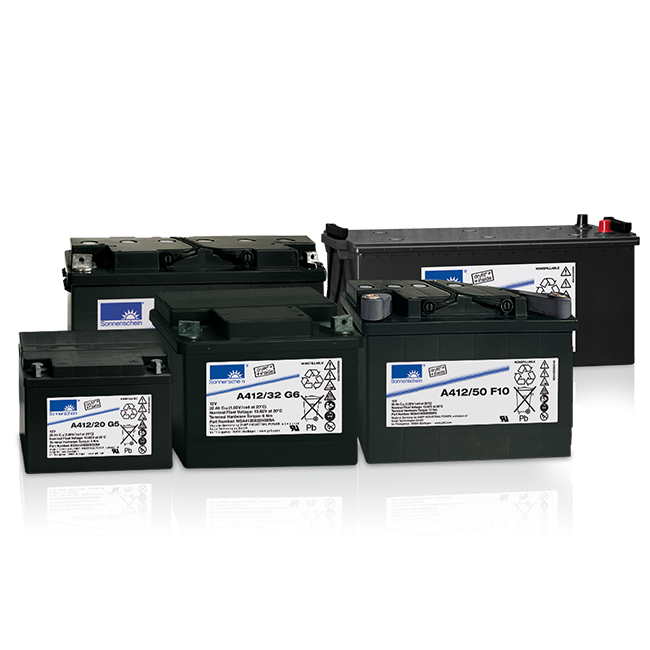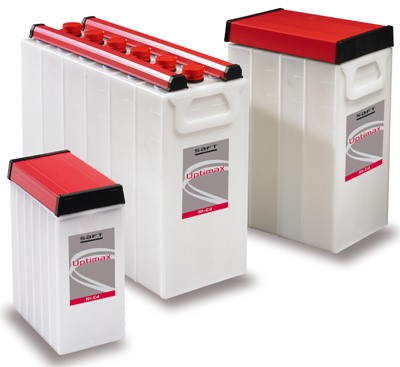Chapter 2 - Industrial Battery Types
IMPORTANT NOTE: To download this chapter in pdf, please visit our Frequently Asked Questions section where you can find it. https://www.norwatt.es/biblioteca.html
Note: To read Chapter 1, please visit: https://www.norwatt.es/noticia-industrial-batteries--features-summary---chapter-1---acronyms-es.html
____________________________________________________________
For the industrial use, the most common battery types available are:
2.1 Lead-acid batteries: Can be Floode####sealed:
Lead-acid battery was invented in 1859 by Gaston Plante and was the first rechargeable battery, and it’s the more used worldwide even actually.
Typical uses:

PbO2 + 2H2SO4 + 2e- → 2H2O + PbSO4 + SO42-
Pb + SO42- → PbSO4 + 2e-
Positive cathode: PbO2
Negative Anode: Pb
Electrolyte: Diluted H2SO4
Lead-acid batteries are composed of a Lead-dioxide cathode, a sponge metallic Lead anode and a Sulphuric acid solution electrolyte.
Main advantages:
Main disadvantages:
|
Characteristic |
Lead- Acid Batteries |
|
Nominal voltage per cell |
2V |
|
Specific energy (Wh/kg) |
30-40 |
|
Energy density (Wh/L) |
50-90 |
|
Cycle life (to 80% original capacity at 100% DOD) |
200-300 (up to 400 at 80% DOD) Traction special types – 1500 up to 1500 cycles |
|
Calendar life (years) |
2 to 8 |
|
Ambient temperature during charge (°C) |
-40-50 ºC |
|
Ambient temperature during discharge (°C) |
40-60 ºC (only some special types) |
|
Self-discharge capacity loss per month |
4-8 % |
|
Memory effect |
No |
|
Toxic metals |
Lead |
|
Battery management system required |
No |
2.2 NiCd batteries: Only flooded
Nickel Cadmium battery was invented in 1899 by Waldemar Jungner.
Typical uses:
In short discharge: start of thermal engines
In long discharges: Rectifiers or back up applications: UPS, substations, railway, planes.

Cd + 2NiOOH + 2 H2O 2Ni(OH)+ Cd(OH)2
Positive cathode: NiOOH
Negative Anode: Cd
Electrolyte: KOH
These type of batteries use nickel hydroxide Ni(OH)2 for the cathode, cadmium Cd for the anode and an alkaline potassium hydroxide for the electrolyte.
Main advantages:
Main disadvantages:
|
Characteristic |
NiCd Batteries |
|
Nominal voltage per cell |
1,2 Vdc |
|
Specific energy (Wh/kg) |
35-80 |
|
Energy density (Wh/L) |
100-150 |
|
Cycle life (to 80% original capacity at 100% DOD) |
300-1000 |
|
Calendar life (years) |
15 -20 |
|
Ambient temperature during charge (°C) |
0-40 ºC |
|
Ambient temperature during discharge (°C) |
-20-70 ºC |
|
Self-discharge capacity loss per month |
15-20% |
|
Memory effect |
Yes |
|
Toxic metals |
Cadmiun |
|
Battery management system required |
No |
2.3 Nickel–Metal Hydride (Ni–MH) Battery
Development was sponsored by Mercedes and Volkswagen for use in EV.
The Ni–MH Battery for EV, HEV or satellite applications (initially).

NiOOH + MH Ni(OH)2 + M
Positive cathode: Ni(OH)2
Negative Anode: MH
Electrolyte: KOH
These cells use nickel hydroxide Ni(OH)2 for the cathode. Hydrogen is used as the active element in a hydrogen-absorbing anode.
Main advantages:
Main disadvantages:
https://www.norwatt.es/archivos/filemanager/2020/06/15_loywrbs11f_Chapter_2_para_FAQ.pdf
LinkedIn:
Rodrigo Suárez - CEO: https://es.linkedin.com/in/rodrigo-suarez-cueto-05ab9357
NORWATT SL:https://cl.linkedin.com/company/norwatt-sl